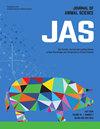Combining in vivo and in vitro approaches to investigate the effect of sainfoin on strongyle infection, immunity and large intestine ecosystem of horses
IF 2.7
2区 农林科学
Q1 AGRICULTURE, DAIRY & ANIMAL SCIENCE
引用次数: 0
Abstract
Sainfoin (Onobrychis viciifolia), a polyphenol-rich plant, has shown promising anti-parasitic properties in ruminants, but results in horses are fewer and inconsistent. The mechanisms of action involved are not fully understood and different factors may influence its anti-parasitic properties. Recently, it has been shown that the effect of sainfoin depends on the horse's diet. Indeed, the inclusion of dehydrated sainfoin pellets in a high starch diet limited the rate of increase in strongyle egg shedding over a short period of time (21 days). The objective of this study was to evaluate, in vivo, the effect of long-term inclusion of sainfoin in a high starch diet on strongyle infection and intestinal health in horses and to compare in vitro anti-parasitic activity of two different dehydrated sainfoin pellets. Horses known to have a past history of strongyle egg excretion (n=16) were allocated to two groups and fed with a high starch diet containing either sainfoin pellets (SF) or control pellets (sunflower and hay) (CONT) for 84 days. In vitro tests including Egg Hatch Test (EHT) and Larval Migration Inhibition Test (LMIT) were performed with different concentrations of aqueous extracts of the sainfoin pellets. No effect of the inclusion of sainfoin in the high starch diet was observed on the number of strongyle eggs excreted in the feces (p=0.671). At the different sampling dates, including sainfoin in a high starch diet induced some changes in the relative abundance of bacterial taxa (e.g., Oscillibacter, p<0.05), but not on bacterial diversity (all p’s>0.05), function (p>0.05) or activity (p>0.05). Adding sainfoin to a high starch diet increased plasma acetate concentration (p=0.032) but no statistically significant differences were observed on other markers of intestinal integrity (plasma lipopolysaccharides) and health (complete blood count) (all p’s>0.05). Both sainfoin pellets showed anti-parasitic activity in the two in vitro tests (all p’s<0.05), and one sainfoin had a stronger anti-parasitic effect than the other (EHT, all p’s<0.05; LMIT, p=0.008). Overall, these results suggest that the anti-parasitic effect of sainfoin may depend on its polyphenolic concentration. Thus, preliminary in vitro testing may help to identify sainfoin best suited for in vivo use.求助全文
约1分钟内获得全文
求助全文
来源期刊

Journal of animal science
农林科学-奶制品与动物科学
CiteScore
4.80
自引率
12.10%
发文量
1589
审稿时长
3 months
期刊介绍:
The Journal of Animal Science (JAS) is the premier journal for animal science and serves as the leading source of new knowledge and perspective in this area. JAS publishes more than 500 fully reviewed research articles, invited reviews, technical notes, and letters to the editor each year.
Articles published in JAS encompass a broad range of research topics in animal production and fundamental aspects of genetics, nutrition, physiology, and preparation and utilization of animal products. Articles typically report research with beef cattle, companion animals, goats, horses, pigs, and sheep; however, studies involving other farm animals, aquatic and wildlife species, and laboratory animal species that address fundamental questions related to livestock and companion animal biology will be considered for publication.
 求助内容:
求助内容: 应助结果提醒方式:
应助结果提醒方式:


